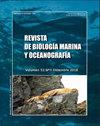Variaciones temporales de las defensas antioxidantes e índices proteína:ADN y ARN:ADN en el poliqueto Eurythoe complanata
IF 0.5
4区 生物学
Q4 MARINE & FRESHWATER BIOLOGY
引用次数: 0
Abstract
espanolAlgunas respuestas antioxidantes e indices instantaneos de condicion (proteinas:ADN y ARN:ADN) fueron determinados en el poliqueto Eurythoe complanata colectado en el Golfo de Cariaco (Venezuela) durante diciembre 2009 (26,03 ± 0,64°C); febrero (23,96 ± 0,67°C), junio (27,82 ± 0,50°C) y octubre 2010 (29,93 ± 0,37°C). Tambien se estimo el numero de ejemplares colectados con senales de regeneracion tisular. Paralelamente, fue llevado a cabo un bioensayo de aclimatacion a 24 y 28°C por un lapso de 36 dias. El tejido muscular se uso para determinar las actividades de las enzimas: catalasa (CAT), glucosa-6-P deshidrogenasa (G6PDH), glutation-S-transferasa (GST); y niveles de dano oxidativo (TBARS), metalotioneinas (MT) y grupos tioles totales (-SH). Ademas, fueron determinados los niveles de ADN, ARN y proteinas, y sus indices relacionados. En la temporada de no surgencia (junio y octubre 2010), caracterizada por temperaturas promedio que sobrepasan los 28°C, fueron observados incrementos en CAT, TBARS y ADN. Sin embargo, las actividades de G6PDH, GST, MT y -SH no presentaron diferencias estacionales ni variaron en los bioensayos de aclimatacion. De igual forma, en la temporada de no surgencia se observo un mayor numero de individuos con senales de regeneracion. Los indices ARN:ADN y PT:ADN demuestran un crecimiento continuo de la especie durante todo el ano y un aumento en la sintesis de proteinas solo en temporadas de bajas temperaturas (surgencia), respectivamente. La capacidad antioxidante, el dano lipoperoxidativo y el crecimiento somatico en E. complanata son estimulados en las temporadas de temperaturas maximas. EnglishSome antioxidant responses and molecular index of growth (protein:DNA and RNA:DNA) were determined in the polychaete Eurythoe complanata collected from Gulf of Cariaco (Venezuela) during December 2009 (26.03 ± 0.64°C), February (23.96 ± 0.67°C), June (27.82 ± 0.50°C) and October 2010 (29.93 ± 0.37°C). Also, the number of individuals with signs of tissue regeneration was counted. Concomitantly, a bioassay of acclimatization was carried out at 24 and 28°C during 36 days. Muscular tissue was used to determine enzymatic activities of catalase (CAT), glucose-6-P dehydrogenase (G6PDH), glutathione-s-transferase (GST); oxidative damage (TBARS), metallothionein (MT) and thiols (-SH) concentrations. DNA, RNA and proteins (PT) concentrations and their related indexes were determined. During `no upwelling' season (June and October 2010), when the mean temperature exceeds 28°C, there were increases in CAT, TBARS and DNA. G6PDH, GST, MT and -SH did not vary seasonally or in acclimatizing bioassays. Similarly, in this season a number of individuals collected with new setigers were observed. RNA:DNA and PT:DNA indices demonstrate a continuous growth of the species throughout the year and a significant increase of protein synthesis in low temperatures season (upwelling), respectively. Somatic growth, lipoperoxidative damage and antioxidant capacity in E. complanata are stimulated in seasons of maximal temperature.多毛类抗氧化防御和蛋白质:dna和rna: dna指数的时间变化
2009年12月(26.03±0.64°C),在委内瑞拉卡里亚科湾采集的Eurythoe Plananata多毛类动物中测定了西班牙的一些抗氧化反应和即时状态指数(蛋白质:DNA和RNA:DNA);2010年2月(23.96±0.67°C)、6月(27.82±0.50°C)和10月(29.93±0.37°C)。还估计了用组织再生信号收集的标本数量。同时,在24和28°C下进行了为期36天的驯化生物测定。肌肉组织用于测定酶的活性:过氧化氢酶(CAT)、葡萄糖-6-P脱氢酶(G6PDH)、谷胱甘肽-S-转移酶(GST);以及氧化损伤(TBARs)、金属硫蛋白(MT)和总硫醇组(SH)的水平。此外,还测定了DNA、RNA和蛋白质水平及其相关指数。在以平均温度超过28°C为特征的非上升季节(2010年6月和10月),CAT、TBARS和DNA都有所增加。然而,G6PDH、GST、MT和SH的活性在驯化生物测定中没有季节性差异或变化。同样,在非紧急季节,观察到更多有反馈信号的个体。RNA:DNA和PT:DNA指数分别显示了该物种全年的持续生长和仅在低温季节(上升)蛋白质合成的增加。在最高温度季节,扁豆的抗氧化能力、脂质过氧化损伤和体细胞生长受到刺激。2009年12月(26.03±0.64°C)、2月(23.96±0.67°C)、6月(27.82±0.50°C)和2010年10月(29.93±0.37°C)在委内瑞拉卡里亚科湾采集的Eurythoe Planata多毛类动物中测定了一些抗氧化反应和生长分子指数(蛋白质:DNA和RNA:DNA)。此外,还统计了有组织再生迹象的个体数量。同时,在24°C和28°C下进行了36天的适应生物测试。肌肉组织用于测定过氧化氢酶(CAT)、葡萄糖-6-P脱氢酶(G6PDH)、谷胱甘肽-S-转移酶(GST)的酶活性;氧化损伤(TBARS)、金属硫蛋白(MT)和硫醇(-SH)浓度。测定DNA、RNA和蛋白质(PT)浓度及其相关指标。在“无上升”季节(2010年6月和10月),当平均温度超过28°C时,CAT、TBAR和DNA增加。G6PDH、GST、MT和-SH没有季节性或适应生物检测。同样,在这个季节,观察到一些用新setigers收集的个人。RNA:DNA和PT:DNA指数显示,该物种全年持续增长,低温季节(上升)的蛋白质合成显著增加。在最高温度的季节,扁豆的生长、脂质过氧化损伤和抗氧化能力受到刺激。
本文章由计算机程序翻译,如有差异,请以英文原文为准。
求助全文
约1分钟内获得全文
求助全文
来源期刊
CiteScore
0.70
自引率
0.00%
发文量
41
审稿时长
12 months
期刊介绍:
Publicar desde una perspectiva científica, artículos originales, decididos por un proceso de revisión por pares, invitando a expertos de reconocido prestigio en el área. Los trabajos publicados se caracterizarán por su solidez teórica-metodológica, actualidad y relevancia para las ciencias marinas.
Se reciben trabajos inéditos derivados de la investigación científica realizada en ambientes marinos y estuarios, en formato de Revisión, Artículos, Notas Científicas, y Obituarios en las siguientes disciplinas::
Biología-Ecología marina
Oceanografía física, química y biológica
Contaminación marina
Geología marina
Sistemática, Faunística y Biogeografía Marina
Manejo Costero
Acuicultura marina
Pesquería marina.

 求助内容:
求助内容: 应助结果提醒方式:
应助结果提醒方式:


